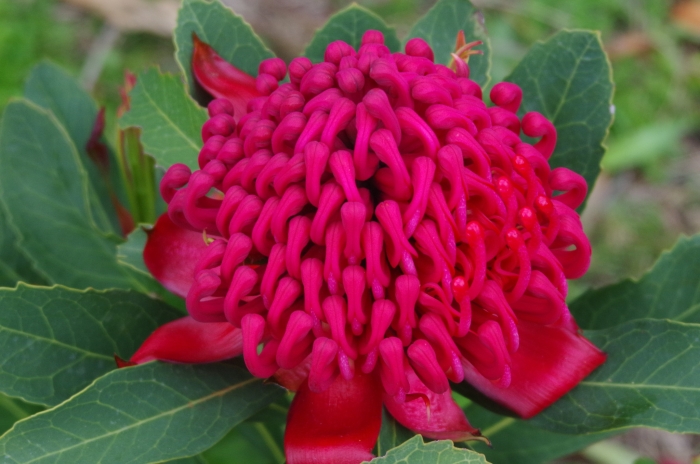Gippsland Waratah
(Telopea oreades)
Gippsland Waratah (Telopea oreades)
/
/

Rotuli
Public Domain Mark 1.0
Image By:
Rotuli
Recorded By:
Copyright:
Public Domain Mark 1.0
Copyright Notice:
Photo by: Rotuli | License Type: Public Domain Mark 1.0 | License URL: https://creativecommons.org/licenses/by/2.0/ | Uploader: Rotuli | Publisher: Flickr |










Estimated Native Range
Summary
Telopea oreades, commonly known as Gippsland Waratah, is an evergreen shrub or small tree in the Proteaceae family, native to the cool temperate rainforests and moist eucalypt forests of Eastern Australia, particularly in Victoria. It can reach a height of up to 19 meters (62 feet), with a single trunk and an erect habit. The Gippsland Waratah is distinguished by its large, showy red flower heads, which are inflorescences that appear in late spring and are composed of up to 60 individual flowers. These flowers are particularly attractive to birds, which are drawn to their nectar.
In cultivation, Gippsland Waratah is valued for its striking floral display and as a focal point in gardens. It is suitable for urban planting, border planting, and as a specimen tree. The plant requires well-drained soil with some clay content and reliable moisture. It is more shade-tolerant than the New South Wales waratah, preferring part-shade but can also tolerate full sun. Moderate frost tolerance is a benefit for gardeners in cooler climates. Pruning old stems and branches can rejuvenate mature plants, and low-phosphorus fertilizer applied in spring and autumn promotes healthy growth. The ’Shady Lady’ series is among the popular cultivars available, offering hybrid vigor and adaptability. Potential problems include root rot in poorly drained soils and susceptibility to Phytophthora cinnamomi. It is not known to be invasive when grown outside its native range.CC BY-SA 4.0
In cultivation, Gippsland Waratah is valued for its striking floral display and as a focal point in gardens. It is suitable for urban planting, border planting, and as a specimen tree. The plant requires well-drained soil with some clay content and reliable moisture. It is more shade-tolerant than the New South Wales waratah, preferring part-shade but can also tolerate full sun. Moderate frost tolerance is a benefit for gardeners in cooler climates. Pruning old stems and branches can rejuvenate mature plants, and low-phosphorus fertilizer applied in spring and autumn promotes healthy growth. The ’Shady Lady’ series is among the popular cultivars available, offering hybrid vigor and adaptability. Potential problems include root rot in poorly drained soils and susceptibility to Phytophthora cinnamomi. It is not known to be invasive when grown outside its native range.CC BY-SA 4.0
Plant Description
- Plant Type: Shrub
- Height: 6-12 feet
- Width: 6-9 feet
- Growth Rate: Moderate
- Flower Color: Red
- Flowering Season: Summer
- Leaf Retention: Evergreen
Growth Requirements
- Sun: Full Sun, Part Shade
- Water: Medium
- Drainage: Medium
Common Uses
Bird Garden, Border Plant, Butterfly Garden, Low Maintenance, Potted Plant, Showy Flowers
Natural Habitat
Cool temperate rainforests and moist eucalypt forests of Eastern Australia
Other Names
Common Names: Gippsland
Scientific Names: , Telopea oreades, Hylogyne oreades,
GBIF Accepted Name: Telopea oreades F.Muell.